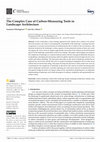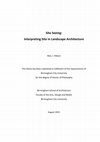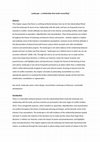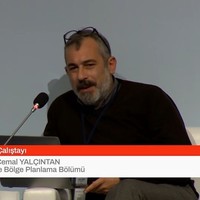Papers by Alex Albans
C, Jul 12, 2023
This article is an open access article distributed under the terms and conditions of the Creative... more This article is an open access article distributed under the terms and conditions of the Creative Commons Attribution (CC BY

C
As the world takes a more strategic approach to the climate crisis, carbon in its various forms h... more As the world takes a more strategic approach to the climate crisis, carbon in its various forms has become a key factor in ascertaining the sustainability of the landscape. Landscape has been recognised as a resource and mechanism for addressing the role of carbon in the environment, with literature focused on the landscape’s carbon capacity as interconnected systems of land, soil, water and organic life. It has, however, largely neglected the crucial role of the cultural, social and historical aspects of the landscape, particularly at the level of design. This paper acknowledges and explores the complexity of landscape as a natural-cultural system with the consequent difficulties this poses in legislating, calculating and measuring carbon for global, national and local targets for low/zero carbon and carbon offsetting. The discussion takes place in the arena of landscape architecture at regional/city/local scales and the life-cycle of a project including its integration into its wi...

C - Journal of Carbon Research, 2023
As the world takes a more strategic approach to the climate crisis, carbon in its various forms h... more As the world takes a more strategic approach to the climate crisis, carbon in its various forms has become a key factor in ascertaining the sustainability of the landscape. Landscape has been recognised as a resource and mechanism for addressing the role of carbon in the environment, with literature focused on the landscape’s carbon capacity as interconnected systems of land, soil, water and organic life. It has, however, largely neglected the crucial role of the cultural, social and historical aspects of the landscape, particularly at the level of design. This paper acknowledges and explores the complexity of landscape as a natural-cultural system with the consequent difficulties this poses in legislating, calculating and measuring carbon for global, na-tional and local targets for low/zero carbon and carbon offsetting. The discussion takes place in the arena of landscape architecture at regional/city/local scales and the life-cycle of a project including its integration into its wider social, cultural and environmental setting. This paper develops the discourse in three major areas: first, by examining how the complexity of landscape is obscured in the context of carbon-measuring tools used in landscape architecture; secondly exploring one such tool in practice to demonstrate how site-specific design decisions can impact carbon levels; and third by proposing how an integrated understanding of landscape can be built into projects to embrace complexity and operationalise low carbon visions.

In landscape architecture, sites are commonly portrayed as being the inspiration behind practitio... more In landscape architecture, sites are commonly portrayed as being the inspiration behind practitioners’ ideas; lending a sense of legitimacy to projects seeking to connect people and place, and strengthening local identity by ‘coming from the site’. In landscape design theory, a site’s history, genius loci (spirit of place) and its physical and cultural contexts are considered to be highly significant shapers of material form in contemporary landscape architecture. Furthermore, professional practice renders the site survey as an exercise in data-gathering and/or as searching for the site’s ‘je ne sais quoi’. Students are encouraged to conduct these investigations neutrally and objectively before any analysis or interpretation. Such conceptions appear to rob novice designers of the confidence in their own decisions because they presume the site must ‘tell’ them what to do. Primarily benefiting students and early-career practitioners, the thesis challenges established ways of understan...
Published in 'Landscape', the Landscape Institute's official journal: No.25, February 2006. ISSN:... more Published in 'Landscape', the Landscape Institute's official journal: No.25, February 2006. ISSN:1742-2914. Wardour Communications Ltd.
The article is a design Review of Coventry's Phoenix regeneration project designed by Rummey Design Associates. It was written during the final year of my Landscape Architecture Post Graduate Diploma as part of a larger investigation.
gees.ac.uk
If facilitated appropriately, fieldwork provides an invaluable opportunity for students to develo... more If facilitated appropriately, fieldwork provides an invaluable opportunity for students to develop many skills both 'generic' (eg teamworking, note-taking, oral - aural - written communication etc.) and geological (eg collection and assimilation of data, application of learning to real ...
Other by Alex Albans
A visual essay about the landscape of Coventry.
Thesis Chapters by Alex Albans

In landscape architecture, sites are commonly portrayed as being the inspiration behind practitio... more In landscape architecture, sites are commonly portrayed as being the inspiration behind practitioners' ideas; lending a sense of legitimacy to projects seeking to connect people and place, and strengthening local identity by 'coming from the site'. In landscape design theory, a site's history, genius loci (spirit of place) and its physical and cultural contexts are considered to be highly significant shapers of material form in contemporary landscape architecture. Furthermore, professional practice renders the site survey as an exercise in data-gathering and/or as searching for the site's 'je ne sais quoi'. Students are encouraged to conduct these investigations neutrally and objectively before any analysis or interpretation. Such conceptions appear to rob novice designers of the confidence in their own decisions because they presume the site must 'tell' them what to do. Primarily benefiting students and early-career practitioners, the thesis challenges established ways of understanding and working with sites, as revealed through the embedded knowledge and expertise of experienced designers. It is an investigation into the circumstances and motivations that shape how landscape architects interpret sites and make design decisions, applicable to education and career-development. A pilot study of 109 award-winning landscape schemes and twenty four in-depth interviews demonstrates how sites are interpreted in light of a complex web of factors and ideas, and not simply 'known' through surveys or consulting the genius loci. It shows that the ideas, experience and knowledge brought to each landscape project are key to a landscape architect's creativity. The study also reveals that sites are interpreted collaboratively, and that stakeholders have very different ideas about sites, all of which can impact working relationships and design decisions. Communication and listening are found to be key factors in professional practice. This research acknowledges the professional importance of the genius loci but reframes it as a name for the process of interpretation and decision-making undertaken by practitioners, based on their skills, knowledge and experience.

In landscape architecture, sites are commonly portrayed as being the inspiration behind practitio... more In landscape architecture, sites are commonly portrayed as being the inspiration behind practitioners' ideas; lending a sense of legitimacy to projects seeking to connect people and place, and strengthening local identity by 'coming from the site'. In landscape design theory, a site's history, genius loci (spirit of place) and its physical and cultural contexts are considered to be highly significant shapers of material form in contemporary landscape architecture. Furthermore, professional practice renders the site survey as an exercise in data-gathering and/or as searching for the site's 'je ne sais quoi'. Students are encouraged to conduct these investigations neutrally and objectively before any analysis or interpretation. Such conceptions appear to rob novice designers of the confidence in their own decisions because they presume the site must 'tell' them what to do. Primarily benefiting students and early-career practitioners, the thesis challenges established ways of understanding and working with sites, as revealed through the embedded knowledge and expertise of experienced designers. It is an investigation into the circumstances and motivations that shape how landscape architects interpret sites and make design decisions, applicable to education and career-development. A pilot study of 109 award-winning landscape schemes and twenty four in-depth interviews demonstrates how sites are interpreted in light of a complex web of factors and ideas, and not simply 'known' through surveys or consulting the genius loci. It shows that the ideas, experience and knowledge brought to each landscape project are key to a landscape architect's creativity. The study also reveals that sites are interpreted collaboratively, and that stakeholders have very different ideas about sites, all of which can impact working relationships and design decisions. Communication and listening are found to be key factors in professional practice. This research acknowledges the professional importance of the genius loci but reframes it as a name for the process of interpretation and decision-making undertaken by practitioners, based on their skills, knowledge and experience.
Drafts by Alex Albans

This chapter argues that there is a striking similarity between how we (in the industrialised Wes... more This chapter argues that there is a striking similarity between how we (in the industrialised West) treat the landscape (in terms of our relationship with the land), and how we frequently treat our enemies in conflict. Certain attitudes are observed in the rhetoric surrounding conflicts which might be characterised as separation, objectification and neutralisation. These three postures are evident throughout the history of landscape architecture theory and practice - whether explicit or implied - and underpin some of the industry’s foundational assumptions. Common across all three attitudes is the disassociation of physical land with human culture which we patch-over with remediation schemes and amelioration projects. The landscape is rich with evidence of the relationship between people and land. As Oakes and Price observe, “landscapes are a faithful mirror in which we can see ourselves reflected” (2008: 176). Through this mirror we see the decisions we’ve made and the values that shape these decisions. It reflects our histories; marks the impact of power and powerlessness; and highlights place and placelessness. Utilising a case study of the railway line between Coventry and Birmingham, this chapter explores how closely the landscape has historically intertwined with culture, as evidenced through the names given to places. Arguing that this legacy has largely been forgotten or ignored since our society industrialised, it suggests that the landscape is all too frequently portrayed as an object rather than a relationship, and that this relationship is detrimentally stripped of value and cultural context. Drawing on lessons from the realm of conflict resolution, the chapter concludes with by advocating reconciliation as a more appropriate approach to resolving the broken relationship(s) between people and the land than amelioration, remediation or regeneration.
Fieldwork in landscape architecture ordinarily centres on a site survey which frequently incorpor... more Fieldwork in landscape architecture ordinarily centres on a site survey which frequently incorporates a dictum to 'sense the spirit of the place' without any clear instruction about how to do this. This draft piece for a forthcoming book charts the journey from confused newbie to a confidence in site interpretation thanks to the pioneering teaching methods of Prof. Kathryn Moore.
Conference Presentations by Alex Albans
Landscape and Infrastructure Conference, 2018
This is the first paper reflecting on my work for the West Midlands National Park Lab and Coventr... more This is the first paper reflecting on my work for the West Midlands National Park Lab and Coventry Cathedral's reconciliation department. It introduces similarities between how we treat our enemies in conflict, and how we treat the landscape, suggesting that our relationship with the landscape is one of conflict. It concludes by asking whether theories and practices of reconciliation might be a way to address this broken relationship.











Uploads
Papers by Alex Albans
The article is a design Review of Coventry's Phoenix regeneration project designed by Rummey Design Associates. It was written during the final year of my Landscape Architecture Post Graduate Diploma as part of a larger investigation.
Other by Alex Albans
Thesis Chapters by Alex Albans
Drafts by Alex Albans
Conference Presentations by Alex Albans
The article is a design Review of Coventry's Phoenix regeneration project designed by Rummey Design Associates. It was written during the final year of my Landscape Architecture Post Graduate Diploma as part of a larger investigation.